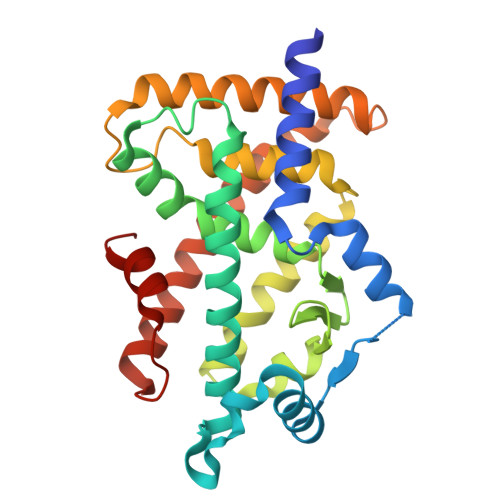Crystal Structures of the Human Peroxisome Proliferator-Activated Receptor (PPAR) alpha Ligand-Binding Domain in Complexes with a Series of Phenylpropanoic Acid Derivatives Generated by a Ligand-Exchange Soaking Method.
Oyama, T., Kamata, S., Ishii, I., Miyachi, H.(2021) Biol Pharm Bull 44: 1202-1209
- PubMed: 34471048
- DOI: https://doi.org/10.1248/bpb.b21-00220
- Primary Citation of Related Structures:
7E5F, 7E5G, 7E5H, 7E5I - PubMed Abstract:
Peroxisome proliferator-activated receptor (PPAR)α, a member of the nuclear receptor family, is a transcription factor that regulates the expression of genes related to lipid metabolism in a ligand-dependent manner, and has attracted attention as a target for hypolipidemic drugs. We have been developing phenylpropaonic acid derivatives as PPARα-targeted drug candidates for the treatment of metabolic diseases. Recently, we have developed the "ligand-exchange soaking method," which crystallizes the recombinant PPARα ligand-binding domain (LBD) as a complex with intrinsic fatty acids derived from an expression host Escherichia (E.) coli and thereafter replaces them with other higher-affinity ligands by soaking. Here we applied this method for preparation of cocrystals of PPARα LBD with its ligands that have not been obtained with the conventional cocrystallization method. We revealed the high-resolution structures of the cocrystals of PPARα LBD and the three synthetic phenylpropaonic acid derivatives: TIPP-703, APHM19, and YN4pai, the latter two of which are the first observations. The overall structures of cocrystals obtained from the two methods are identical and illustrate the close interaction between these ligands and the surrounding amino acid residues of PPARα LBD. This ligand-exchange soaking method could be applicable to high throughput preparations of co-crystals with another subtype PPARδ LBD for high resolution X-ray crystallography, because it also crystallizes in complex with intrinsic fatty acid(s) while not in the apo-form.
Organizational Affiliation:
Faculty of Life and Environmental Sciences, University of Yamanashi.















